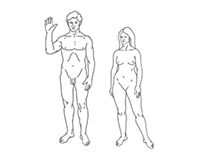Defensive pessimism is a cognitive strategy identified by social psychologist Nancy Cantor and her students in the mid-1980s. Individuals use defensive pessimism as a strategy to prepare for anxiety provoking events or performances. When implementing defensive pessimism, individuals set low expectations for their performance, regardless of how well they have done in the past. Defensive pessimists then think through specific negative events and setbacks that could adversely influence their goal pursuits. By envisioning possible negative outcomes, defensive pessimists can take action to avoid or prepare for them, advantageously harnessing anxiety that might otherwise harm their performance.
The strategy is utilized in a variety of domains. In public speaking venues defensive pessimists can alleviate anxiety by imagining possible obstacles such as forgetting the speech, being thirsty, or staining their shirt before the event. Because defensive pessimists have thought of these problems, they can appropriately prepare to face the challenges ahead. The speaker could, for instance, create note cards with cues about the speech, place a cup of water on the podium to alleviate thirst, and bring a bleach pen to remove shirt stains. These preventative actions both reduce anxiety and promote superior performance.
Prefactual thinking, synonymous with anticipation, describes the cognitive strategy in which people imagine possible outcomes of a future scenario. The imagined outcomes are either positive/desirable, negative/undesirable, or neutral. Prefactual thinking can be advantageous because it allows the individual to prepare for possible outcomes of a scenario. For defensive pessimists, prefactual thinking offers the primary and critical method to alleviate anxiety. Usually, this prefactual thinking is paired with a pessimistic outlook, resulting in negative/undesirable imagined scenarios.
When compared to individuals who employ an optimistic strategy (e.g. visualizing the event going off without a hitch) defensive pessimists are normally less satisfied with their performances and rate themselves higher in ‘need for improvement.’ However, in actuality their performance is on par with their more sanguine counterparts. Cantor investigated whether encouraging defensive pessimists, and thereby interfering with their typical negative thinking, would result in worse performances. Participants in her study completed a series of puzzles and anagrams. The control group (which was not instructed) outperformed the experimental group, which was told beforehand that their high GPA’s indicated they would do well. Defensive pessimism is an adaptive strategy for those who struggle with anxiety: their performance decreases if they are unable to appropriately manage and counteract their concerns.
As defensive pessimism is motivated by a need to manage anxiety, it is unsurprisingly also correlated with trait anxiety and neuroticism. Negative mood states promote defensive pessimists’ goal attainment strategy by facilitating their generation of setbacks and negative outcomes that could arise during goal pursuit. When defensive pessimists are encouraged into positive or even just neutral mood states, they perform worse on experimental tasks than when in a negative mood state. They are more anxious because they are prevented from properly implementing their preferred cognitive strategy for goal attainment.
Defensive pessimism is generally related to lower self-esteem since the strategy involves self-critique, pessimism, and discounting previous successful performances. Indeed, a 2006 study found that, compared to optimists, defensive pessimists had lower self-esteem entering college. At the end of four years of college however, the self-esteem of the defensive pessimists had increased to nearly equal levels. The self-esteem of optimists had not changed, and the self-esteem of pessimists who did not employ defensive pessimism had fallen slightly by the end of college. While defensive pessimism may have implications for self-esteem, it appears that these effects lessen over time.
Unlike pessimism, defensive pessimism is not an internal, global, and stable attribution style, but rather a cognitive strategy utilized within the context of certain goals. Pessimism involves rumination about possible negative outcomes of a situation without proactive behavior to counteract these outcomes. Defensive pessimism, on the other hand, utilizes the foresight of negative situations in order to prepare against them. The negative possible outcomes of a situation often motivate defensive pessimists to work harder for success. Since defensive pessimists are anxious, but not certain, that negative situations will arise, they still feel that they can control their outcomes. For example, a defensive pessimist would not avoid all job interviews for fear of failing one. Instead, a defensive pessimist would anticipate possible challenges that could come in an upcoming job interview – dress code, stubborn interviewers, and tough questions – and prepare rigorously to face them. Defensive pessimism is not a reaction to stressful events nor does it entail ruminating on events of the past, and should therefore be distinguished from trait pessimism or a more general negative outlook. Instead, defensive pessimists are able to stop using this strategy once it is no longer adaptive (does not serve a preparatory role).
A 2003 study determined that people adopt defensive pessimism or self-handicapping strategies for similar reasons: to deal with anxiety provoking situations. Self-handicapping is a cognitive strategy in which people construct obstacles to their own success to keep failure from damaging their self-esteem. The difference between self-handicapping and defensive pessimism lies in the motivation behind the strategies. Beyond managing anxiety, defensive pessimism is further motivated by a desire for high achievement. Self-handicappers, however, feel no such need, being high in avoidance motivation and low in approach motivation. They wanted to avoid anxiety, but were not motivated to approach success.
In research, defensive pessimism is frequently contrasted with strategic optimism, another cognitive strategy. When facing performance situations, strategic optimists feel that they will end well. Therefore, though they plan ahead, they plan only minimally because they do not have any anxiety to face. While defensive pessimists set low expectations, feel anxious, and rehearse possible negative outcomes of situations, strategic optimists set high expectations, feel calm, and do not reflect on the situation any more than absolutely necessary. Strategic optimists start out with different motivations and obstacles: unlike defensive pessimists, they do not have any anxiety to surmount. Despite differences in motivation, both strategies have similar objective performance outcomes.
The Daily Omnivore
Everything is Interesting



Leave a comment